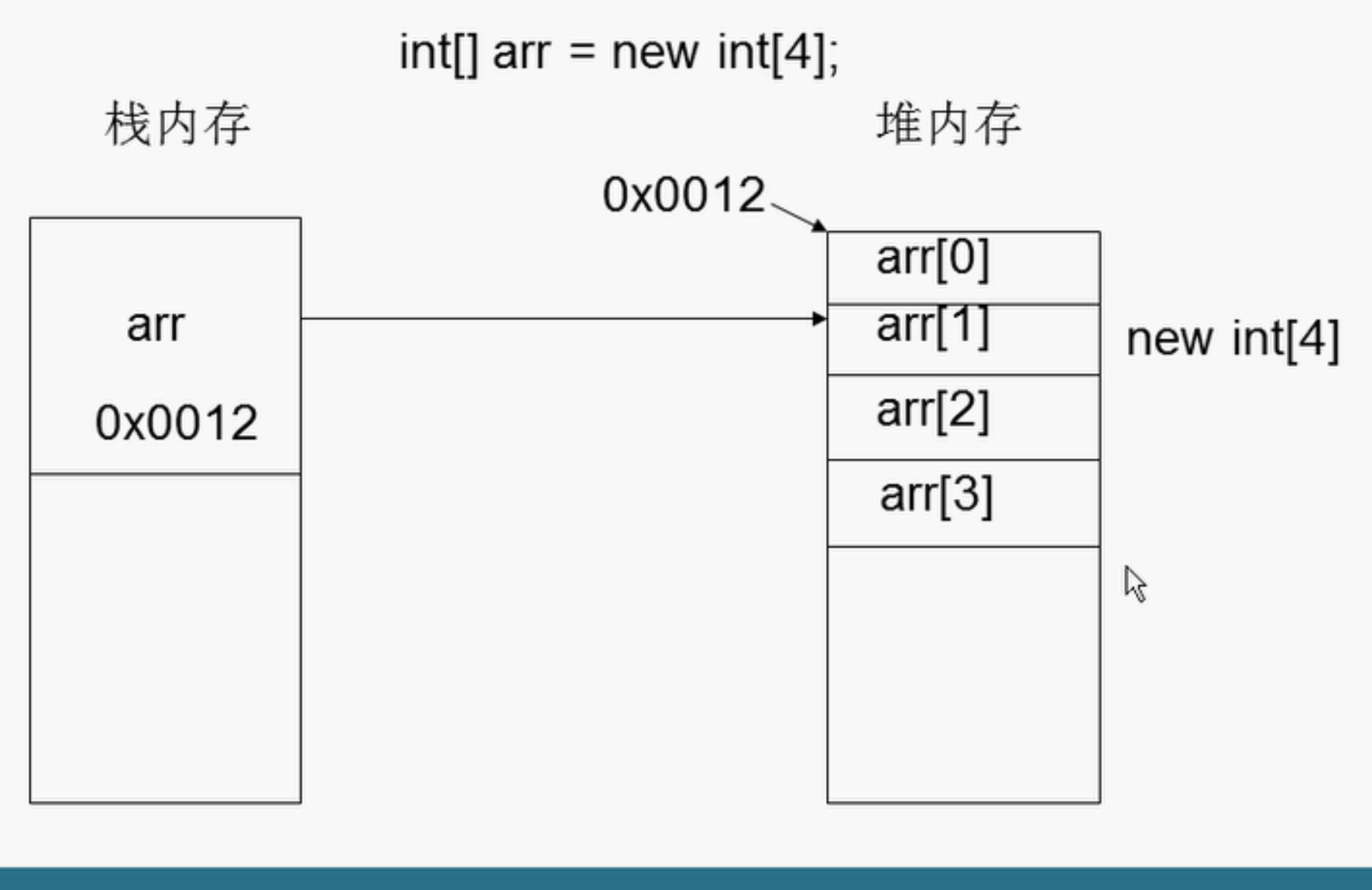@zhangyy
2017-11-29T02:36:50.000000Z
字数 4376
阅读 406
Java 的函数和数组
Java基础系列
1. 函数的定义
函数,function,方法 method函数不可以嵌套定义函数就是定义在类中的具有特定功能的一段独立小程序。函数又称为方法。
1.1 Java的函数格式
函数格式修饰符 返回值类型 函数名(类型 名称1,....){ //函数体.....return ; //返回值类型}返回值类型,函数运行后的结果的数据类型参数类型, 是形式参数的数据类型形式参数:是一个变量,用于存储调用函数式传递给函数的实际参数实际参数:是传递形式参数的具体数值return :用于结束函数返回值:该函数运算后的结果,该结果会返回给调用者。
1.2 函数的特点
1. 定义函数可以将功能代码进行封装2. 便于对该功能进行复用3. 函数只有被调用才会被执行4. 函数的出现提高了代码的复用性5. 对于函数没有具体返回值的情况,返回值类型用关键字void表示,那么该函数中的return语句如果在最后一行可以省略 不写注意:1. 函数中 只能调用函数,不可以在函数内部定义函数2. 定义函数时,函数的结果应该返回给调用者,交由调用者处理
1.3 函数的调用
1. 一般在主方法的中调用
- 1.3.1 实例:
class funcationDemo{public static void main(String[] args){System.out.println("hello world");int a = 1int b = 2int c = add(a,b);System.out.println(c)}public static int add (int a, int b){// int res = a + b ;return a + b ;}}
package FuncationDemo;public class FuncationDemo {public static void main(String[] args) {int a =1;int b =2;int c = add(a,b);System.out.println("c="+c);hello("hello world");}public static int add (int a , int b) {return a + b ;}public static void hello(String mes) {System.out.println(mes);}}
package day03;public class max {public static void main(String[] args) {// TODO Auto-generated method stubSystem.out.println(max(1,2,3));}public static int max(int a ,int b ,int c) {int max = a > b? a:b;max = max >c ? max : c ;return max ;}}
package day03;public class he {public static void main(String[] args) {// TODO Auto-generated method stubSystem.out.println("sum ="+sum(100));}public static int sum(int a) {int sum = 0;for(int i = 1 ; i<=a ; i++ ) {sum +=i ;}return sum;}}

package day03;public class HeSumDemo {public static void main(String [] args) {jiujiu(9);}public static void jiujiu(int row) {for (int i =1 ; i <= row ; i++) {for(int j =1; j<=i ; j++) {System.out.print(j + "*" + i + "=" + (j * i) + "\t");}System.out.println();}}}

- 1.3.2 递归
// 阶乘计算递归package day03;public class JieChen {public static void main(String[] args) {// TODO Auto-generated method stubSystem.out.println("5!="+fanc(5));}public static int fanc(int n) {if (n == 1) {return 1;}return n* fanc(n-1);}}

1.4 函数的应用
一: 两个明确1. 明确定义的功能最后的结果是什么?2. 明确在定义该功能的过程中,是否需要未知内容参与运算二: 示例:1. 需求:定义一个功能,可以实现两个整数的加法运算。2. 分析:该功能的运算结果是什么? 两个数的和,也是一个整数(int)在实现改功能的过程中是否有未知内容参与运算?加数和被加数是不确定的 (两个参数int,int)代码:int getSum(int x ,int y){return x+y;}
1.5 函数的重载
重载的概念:在同一个类当中,允许存在一个以上的同名函数,只要他们的参数个数或者参数类型不同即可。重载的特点:与返回值类型无关,只看参数列表、重载的好处:方便与阅读,优化了程序设计。重载实例:// 返回两个整数的和int add(int x , int y){return x+y;}// 返回三个整数的和:int add(int x , int y , init z){return x+y+z;}//返回两个小数的和double add(double x , double y){return x+y;}
2. java 的数组
2.1 什么是数组:
概念:同一种类型数据的集合,其实数组就是一个容器数组的好处:可以自动给数组中的元素从0开始编号,方便操作这些元组格式1:元素类型[] 数组名 = new 元素类型[元素个数或数组长度]实例: int [] arr = new int[5];格式2:元素类型[] 数组名 = new 元素类型[] {元素,元素}int [] arr = new int[] {3,5,1,7};int [] arr = {3,5,1,7};
package day03;public class arr01 {public static void main(String[] args) {// TODO Auto-generated method stub// 定义一个数组int [] arr = new int [5]; // 表示长度//java.lang.ArrayIndexOutOfBoundsException 数组的下标越界int [] arr01 = new int [] {8,7,6,5,4};int [] arr02 = {1,2,4,5,7,8};//java.lang.NullPointerException 空指针异常int [] arr03 = null;// length 是属性System.out.println(arr.length);System.out.println(arr01[1]);System.out.println(arr02[2]);System.out.println(arr03.length);}}
注意:java 是没有指针没有显示的指针操作,引用就是指针。指针就是对象的内存地址,null 对象不存在,不能访问其属性和方法,否则 就是会出现空指针异常。
2.2 数组的结构:

- 2.2.1:给定一个数组求最大值与最小值:
package day03;public class ArrayTest {/**给定一个数组{5,1,6,4,2,8,9}获取数组中的最大值,以及最小值。* @param args*/public static void main(String[] args) {// TODO Auto-generated method stubint []arr ={5,1,6,4,2,8,9};int max=getMax(arr);int min=getMin(arr);System.out.println("max="+max);System.out.println("min="+min);}public static int getMax(int []arr){int max = arr[0];for(int x=1;x<arr.length;x++){if(arr[x]>max)max=arr[x];}return max;}public static int getMin(int []arr){int min = arr[0];for (int x=1;x<arr.length;x++){if(arr[x]<min)min=arr[x];}return min;}}

- 2.2.2 java 的冒泡排序:
冒泡排序(Bubble Sort)是一种简单的排序算法。它重复地走访过要排序的数列,一次比较两个元素,如果他们的顺序错误就把他们交换过来。走访数列的工作是重复地进行直到没有再需要交换,也就是说该数列已经排序完成。这个算法的名字由来是因为越小的元素会经由交换慢慢“浮”到数列的顶端。冒泡排序算法的运作如下:比较相邻的元素。如果第一个比第二个大,就交换他们两个。对每一对相邻元素作同样的工作,从开始第一对到结尾的最后一对。在这一点,最后的元素应该会是最大的数。针对所有的元素重复以上的步骤,除了最后一个。持续每次对越来越少的元素重复上面的步骤,直到没有任何一对数字需要比较。
public class BubbleSort{public static void main(String[] args){int score[] = {67, 69, 75, 87, 89, 90, 99, 100};for (int i = 0; i < score.length -1; i++){ //最多做n-1趟排序for(int j = 0 ;j < score.length - i - 1; j++){ //对当前无序区间score[0......length-i-1]进行排序(j的范围很关键,这个范围是在逐步缩小的)if(score[j] < score[j + 1]){ //把小的值交换到后面int temp = score[j];score[j] = score[j + 1];score[j + 1] = temp;}}System.out.print("第" + (i + 1) + "次排序结果:");for(int a = 0; a < score.length; a++){System.out.print(score[a] + "\t");}System.out.println("");}System.out.print("最终排序结果:");for(int a = 0; a < score.length; a++){System.out.print(score[a] + "\t");}}}



